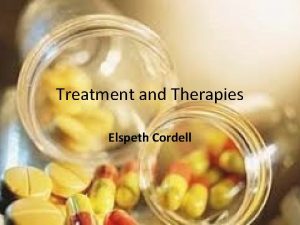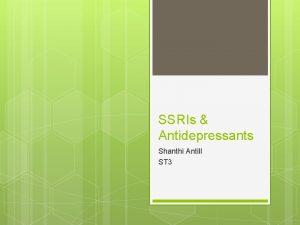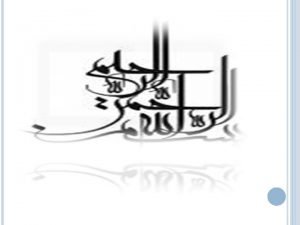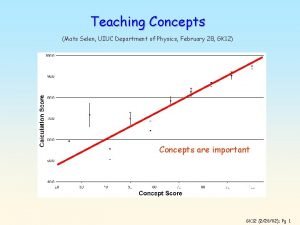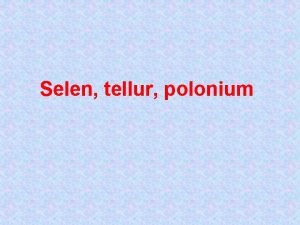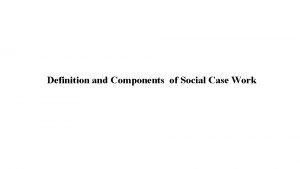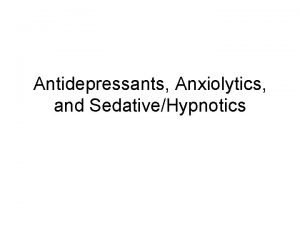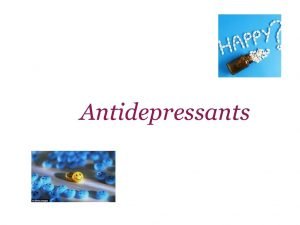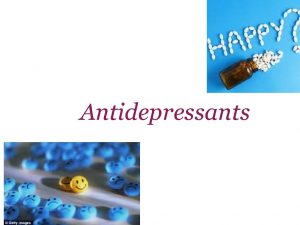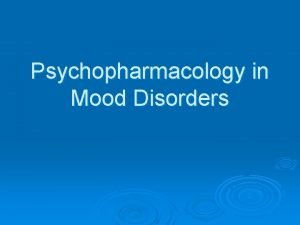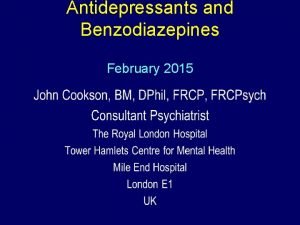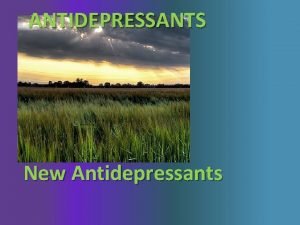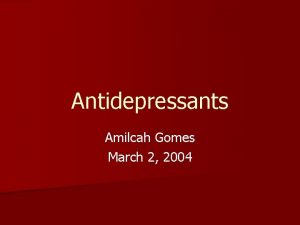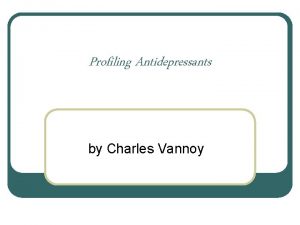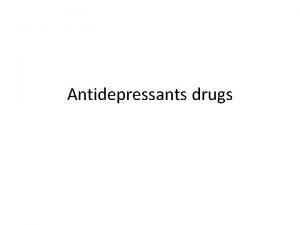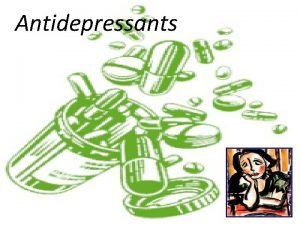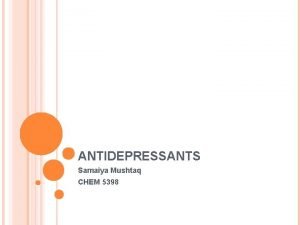HOW DO ANTIDEPRESSANTS WORK ON DEPRESSION Selen AK
















- Slides: 16

HOW DO ANTIDEPRESSANTS WORK ON DEPRESSION? Selen AK 1803337 PSYC-374

Outline • Introduction ▫ Definition of depression ▫ Symptoms ▫ Treatment • How Serotonin& Norephinephrine Works? • Types of antidepressants ▫ TCAs ▫ MAOIs ▫ SSRIs • Tolerance and withdrawal symptoms • Conclusion

Definition of Depression • “An affective disorder characterized by loss of interest or pleasure in almost all a person’s usual activities or pastimes. ”

Symptoms Associated With Depression • Sadness, Despair, Guilt, Pessimism • Decrease in energy • Decrease in sex drive • Insomnia and fatigue • Thoughts of death and suicide • Mental slowing, lack of concentration • Experiments show that low level of serotonin cause these symtoms.

Treatment of Depression • Physiological Treatments ▫ Drug Therapies �Tricyclic antidepressants (TCAs) �Monoamine oxidase inhibitors (MAOIs) � Selective serotonin reuptake inhibitors (SSRIs) ▫ Electroconvulsive therapy (ECT) • Psychological Treatments ▫ Cognitive behaviour therapy (CBT) ▫ Behaviour therapy ▫ Interpersonal therapy (IPT)

Treatment (Cont. ) • Evolution of drug therapy ▫ Antidepressants discovered accidentally while investigating antipsychotic efficacy of modifications of phenothiazines ▫ Imipramine - first antidepressant discovered ▫ Around the same time, monoamine oxidase inhibitors were identified ▫ Second generation antidepressants identified to address problems with first generation antidepressants ▫ Late 1980’s- SSRI’s were developed ▫ Now working on other antidepressant treatments ▫ Also used for treatment of other disorders including: -Anxiety disorders, dysthymia, chronic pain and behavioral problems

Serotonin& Norephinephrine’s Working Principle • Serotonin (ser-o-TOEnin) and norepinephrine (norep-ih-NEF-rin) reuptake inhibitors ease depression by affecting chemical messengers (neurotransmitters) used to communicate between brain cells.

Effects of Serotonin: • Serotonin is involved in: ▫ ▫ ▫ appetite sleep memory learning temperature mood behavior Depression (People with depression have significantly fewer serotonin receptors in the hippocampus) cardiovascular function endocrine regulation regulating aging bone metabolism

Effects of Norephinephrine • Normally produces effects such as: ▫ ▫ ▫ increased heart rate, increased blood pressure, widening of pupils, widening of air passages in the lungs narrowing of blood vessels in non-essential organs. • This enables the body to perform well in stressful situations.

1. Tricyclics Antidepressants � Inhibiting reuptake of norepinephrine and serotonin. TCAs are called tricyclic because their chemical structure contained three rings. �The oldest antidepressants �Take 2 -4 weeks to work fully �Side Effects: weight gain, loss of sex drive, dizziness and nausea, dry mouth, blurred vision, increased heart rate

2. Monoamine oxidase inhibitors (MAOIs) � Inhibiting reuptake of norepinephrine and serotonin � Particularly effective in treating atypical depression � Combining MAO inhibitors with foods or drinks containing tyramine can result in dangerously high blood pressure, which can lead to a stroke or heart attack � Used only when other classes of antidepressant drugs have failed • Side Effects: dizziness, insomnia, weight gain, headaches, sexual problems, daytime sleepiness

3. Selective serotonin reuptake inhibitors (SSRIs) �Increase activity of serotonin �The most commonly prescribed class of antidepressants �Milder side effects than other antidepressants �Reduce depressive symptoms more rapidly �Their adverse effects are less severe • Side Effects: nausea, insomnia, dizziness, weight gain or loss, tremors, sweating, anxiety and restlessness, decreased sex drive, drowsiness or fatigue, dry mouth, diarrhea, headaches https: //www. youtube. com/watch? v=G 4 r 3 q. Ck. LUDQ

Tolerance and withdrawal • Both side effects and main effects show tolerance • Withdrawal can happen. . ▫ ▫ Agitation Nervousness Chills Muscle aches • Easier to keep people on SSRIs

Conclusion • Criticisms of Drug Treatments: ▫ Do not “cure” the disorder ▫ Do not teach client coping and problem solving skills to deal with life problems ▫ High relapse rate ▫ SSRIs increase risk of suicide ▫ So, ▫ Best Treatment: both drug & psychological therapies.

References • Dukes, M. , & Garattini, S. (1967). Antidepressant drugs (1 st ed. ). Amsterdam: Excerpta Medica Foundation. • Freberg, L. (2006). Discovering biological psychology (1 st ed. ). Boston: Houghton Mifflin. • Friedman, R. , & Leon, A. (2007). Expanding the black box—depression, antidepressants, and the risk of suicide. New England Journal Of Medicine, 356(23), 2343 --2346 • Gartlehner, G; Hansen, RA; Morgan, LC; Thaler, K; Lux, L; Van Noord, M; Mager, U; Thieda, P; Gaynes, BN et al. (2011). "Comparative Benefits and Harms of Second-Generation Antidepressants for Treating Major Depressive Disorder: An Updated Meta-analysis". Annals of Internal Medicine 155 (11): 772– 85. doi: 10. 7326/0003 -4819 -155 -11 -201112060 -00009. • Kalat, J. (1998). Biological psychology (1 st ed. ). Pacific Grove, CA: Brooks/Cole Pub. Co. • Rickels, K. , Raab, E. , De. Silverio, R. , & Etemad, B. (1967). Drug treatment in depression: antidepressant or tranquilizer? . Jama, 201(9), 675 --681. • Sivagnanam, G (2012). Antidepressants. Journal of Pharmacology and Pharmacotherapeutics 3 (3): 287– 8. • Wheeler, V. , Mortimer, A. , & Tyson, P. (2003). Conventional antipsychotic prescription in unipolar depression, I: an audit and recommendations for practice. The Journal Of Clinical Psychiatry, 64(5), 568 --574.

THANK YOU FOR YOUR ATTENTION!
 Selen depression
Selen depression Antidepressants meds list
Antidepressants meds list Switching antidepressants chart
Switching antidepressants chart Tricyclic antidepressants overdose
Tricyclic antidepressants overdose Selen deviren saygın
Selen deviren saygın Mats selen uiuc
Mats selen uiuc Oxid tellurnatý
Oxid tellurnatý 1979 türkiye güzeli şebnem ünal
1979 türkiye güzeli şebnem ünal What is remedial social work
What is remedial social work I work all night
I work all night Work immersion grading system
Work immersion grading system What is social casework?
What is social casework? Smart work vs hard work group discussion
Smart work vs hard work group discussion Hard work or smart work
Hard work or smart work Physics 03-01 work and the work-energy theorem
Physics 03-01 work and the work-energy theorem Work group vs work team
Work group vs work team Shs work immersion
Shs work immersion

